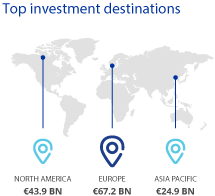Library
Downloads
INREV Young Professionals Conference 2018 presentations
Published on 10 Jul 2018
The INREV Young Professionals Conference was held in Budapest on 5 and 6 July under the theme 'Remaining resilient through change'.
Philip Coggan - Trade offs: threats to global growth
DownloadBrian Klinksiek - Repeat business: how is this cycle different?
DownloadGustaf Lilliehöök - Blurring the lines: the evolving shape of real estate
DownloadDan Hughes - Inside information: how will tech transform real estate
DownloadHans de Jonge - Shaping cities of the future
DownloadGlobal Best Practices for Fees and Expense Metrics Webinar
Published on 28 May 2018
This session, led by Renaud Breyer, EY, and Barbara Flusk, Citco Fund Services, examines the current market practices in fees and expense metrics and their related disclosures as well as presenting the new Total Global Expense Ratio (TGER) – the first globally consistent measure for real estate investment vehicle fees and costs which INREV, ANREV, NCREIF and PREA jointly developed.
The webinar covers:
- INREV Guidelines for calculation and disclosure of fees and expense metrics
- NCREIF PREA Reporting Standards measure of fund fee load
- Global initiative on Total Global Expense Ratio
- Benefits of implementing these guidelines
The webinar will be of interest for investors, fund managers as well as advisors. It will be of particular interest for investment managers who work in fund reporting and those on the product development side who are interested in trends in fee terms and structures.
Fund Manager Survey 2018
Published on 22 May 2018
This year’s survey includes 162 managers and represents total real estate assets under management of €2.7 trillion as at end 2017.
INREV Investor Only Seminar
Published on 07 May 2018
The INREV Investors Only Seminar is where investors can share investor insights and expertise, exclusively within the INREV investor community. Around 100 investors come together each year to discuss topics specific to investors’ needs.
INREV Annual Conference
Published on 07 May 2018
The flagship event of the non-listed real estate industry. Over 400 senior industry experts, from across Europe and beyond. Leading institutional real estate insights and thought-provoking global perspectives
INREV Annual Report 2017
Published on 01 May 2018
The INREV Annual Report 2017 is out and will take you through the key highlights and achievements of 2017. View an interactive version of the report or download PDF below.
INREV gets ready for GDPR
Published on 24 Apr 2018
INREV aims to ensure that ‘personal data’ is processed in a way that is fair, lawful and transparent to our members. This overview outlines the steps that we have taken.
INREV 15th anniversary
Published on 12 Apr 2018
The INREV Annual Conference 2018 Dublin opened with a bang to celebrate INREV’s 15th anniversary. We have matured a great deal as an industry over the past 15 years and are in a good position 7 years into the recovery of this cycle. At this time, when things are positive, we need to ensure we are ready for the stormy times ahead.
Annual Conference 2018 Dublin: presentations and video
Published on 12 Apr 2018
The INREV Annual Conference 2018 was held in Dublin on 11 and 12 April under the theme 'Finding value in later-cycle investing'. To catch up an overview of the highlights, presentations, a short video and lots of images.
Michael Heise - Identifying the risk amid global growth
DownloadAlice Breheny - Europe mega trends and peak pricing
DownloadMark Roberts - North America mega trends and peak pricing
DownloadGlyn Nelson - Asia mega trends and peak pricing
DownloadMegan Walters - Global investor debate: allocations and expectations in a liquid market
DownloadClaire Penny - Embracing disruption: innovation and data in real estate
DownloadMarieke van Kamp - Highlights of the INREV Annual Conference 2018 Dublin
DownloadCapital Raising Survey 2018
Published on 10 Apr 2018
The Capital Raising Survey is a backward-looking analysis of recent capital raising activities by region, investment strategy, style, structure and other factors. This survey has been conducted annually since 2006. Since 2015, the survey has been global in scope, thanks to the involvement of ANREV and NCREIF.
